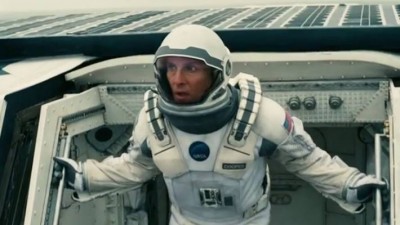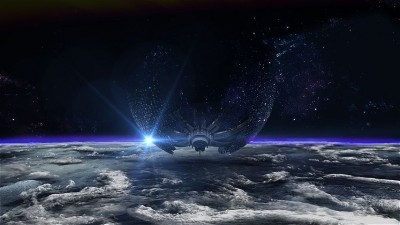
Interstellar – a film review by Gary Chew
The boiled-down message in Interstellar is that “Love transcends all dimensions,” especially when you get to the part of the movie when Matthew McConaughey winds up in a space-time that has not four but five dimensions. That isn’t so much a spoiler as it is just something to hang your space suit on as you’re tripped though almost three hours of a Christopher Nolan movie of near epic proportions. It spins “across the gulf of time” (to quote Bob Dylan), starting at a down-on-the farm cornfield all the way through a worm hole and, would you believe(?), a near flyby of a black hole … all of it right comfy for the family (PG-13). How’s that for bringing in an audience?
 Once more, Stanley Kubrick is all over the place on another sci-fi picture. I kept thinking I was about to hear The Blue Danube Waltz again, but no … Nolan gives us hope. Kubrick wasn’t so big on hope. But Nolan does allow a brief scene of what I’d call a “Gary Lockwood Moment” as one of the space-suited persons spins alone in the vast void. Today, that kind of a movie scene in space should be called a “Sandra Bullock Moment.”
Once more, Stanley Kubrick is all over the place on another sci-fi picture. I kept thinking I was about to hear The Blue Danube Waltz again, but no … Nolan gives us hope. Kubrick wasn’t so big on hope. But Nolan does allow a brief scene of what I’d call a “Gary Lockwood Moment” as one of the space-suited persons spins alone in the vast void. Today, that kind of a movie scene in space should be called a “Sandra Bullock Moment.”
Speaking of Gravity, Interstellar is awesome for your eyes. It may have Gravity beaten on that count. As it goes, gravity proves to be an integral part of solving a space-time mystery that begins in the home library of a simple, but highly educated widower/engineer/pilot/farmer named Cooper (McConaughey). Cooper’s father-in-law, played by John Lithgow, and Cooper’s son and daughter also live on the farm.
The farmer/father has been grounded from space flight for more important duty on Earth. That would be producing enough food for people who live on our planet. The weather is really acting up … all over. It looks like the Dust Bowl days of the Thirties in America’s heartland. The script doesn’t mention climate change, but Interstellar paints that picture well.
Almost as if by the magic one would find in a pickup-truck fairytale, Cooper and his daughter, Murph — played in three stages by MacKenzie Foy, Jessica Chastain and Ellen Burstyn — discover a top secret lab and construction venue for development of an advanced space vehicle. It’s subterranean and only a cornfield or two over from Coop’s spread.
 Eureka, it’s a secret NASA installation — not in Houston. Scientists and other smart people there have, for many years, been tasked to figure out a way to save part of civilization by means of locating another spot in the universe to inhabit.
Eureka, it’s a secret NASA installation — not in Houston. Scientists and other smart people there have, for many years, been tasked to figure out a way to save part of civilization by means of locating another spot in the universe to inhabit.
The few planets the smart people have been able to target for re-colonizing are orbiting in another galaxy — far, far away. Alas, that requires the seeker/explorers to travel through a worm hole to get to that galaxy before life on Earth is no longer sustainable … and considering the relativity factor of time and space, that’s not going to be an easy fix.
Besides the enormous lift and thrust of the mighty space craft in Interstellar, Hans Zimmer’s “organish” music elevates much as Michael Nyman’s memorable score does in the 1997 hit Gattaca. Zimmer also seems to be fond of Richard Strauss cadences that stretch into organ solos akin to those trailing out in Also Sprach Zarathustra. Now that is Kubrickian.
IMAX audio in the complex where I attended the screening literally shook my body, especially at liftoff. Otherwise, sounds and music were constantly overriding the dialogue track to the extent I knew I should learn to read lips if I ever want to see Interstellar again. (Maybe they could add English subtitles for English-speaking patrons to the film.) For the first time in my movie-going experience, the music and the sound were larger than the images on the gigantic screen that stretched across one entire wall of the auditorium.
Another message in Interstellar, as potent as the one about love, is “Learn to think like a species.”
- Movie Review: ‘The Glorias’ - September 28, 2020
- Movie Review: ‘I’m Thinking of Ending Things’ - September 10, 2020
- Movie Review: ‘The Burnt Orange Heresy’ - August 31, 2020

